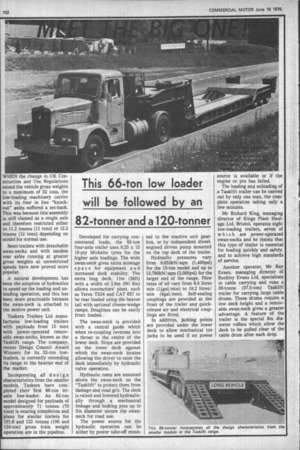This 66-ton low loader will be followed by an 82-tonner and a120-tonner
Page 104

If you've noticed an error in this article please click here to report it so we can fix it.
WHEN the change in UK Construction and Use Regulations raised the vehicle gross weights to a maximum of 32 tons, the low-loading machinery carrier with its four in line "knockout" axles suffered a set-back. This was because this assembly is still classed as a single axle and therefore restricted either to 11.2 tonnes (11 tons) or 12.2 tonnes (12 tons) depending on model for normal use.
Semi-trailers with detachable swan-necks and with tandem rear axles running at greater gross weights at unrestricted speeds have now proved more popular.
A natural development has been the adoption of hydraulics to speed up the loading and unloading operation, and this has been more practicable because the swan-neck is attached to the motive power unit.
Taskers Trailers Ltd manufactures low-loading trailers with payloads from 15 tons with power-operated removable swan-necks, known as the Tasklift range. The company, recent Design Council Award Winners for its 32-ton lowloaders, is currently extending its range to the heavier end of the market.
Incorporating all design characteristics from the smaller models, Taskers have completed their first 66-ton tri: axle low-loader. An 82-ton model designed for payloads of approximately 71 tonnes (70 tons) is nearing completion and plans for similar trailers for 101.6 and 122 tonnes (100 and 120-ton) gross train weight operation are in the pipeline. Developed for carrying concentrated loads, the 82-ton four-axle trailer uses 8.25 x 15 18-ply Michelin tyres for the higher axle loadings. The wide swan-neck gives extra stowage space for equipment and increased deck stability. The extra long deck, 1 1m (36ft) with a width of 2.9m (9ft 6in) allows contractors' plant, such as Terex TS24 and CAT 657 to be rear loaded using the beaver tail with optional cheese-wedge ramps. Draglines can be easily front loaded.
The swan-neck is provided with a central guide which when re-coupling reverses into a throat in the centre of the lower deck. Stops are provided on the lower deck against which the swan-neck locates allowing the driver to raise the deck immediately by hydraulic valve operation.
Hydraulic rams are mounted above the swan-neck on the "Tasklift" to protect them from damage and road grit. The deck is raised and lowered hydraulically through a mechanical linkage and locking pins up to 3in diameter secure the swanneck for road use.
The power source for the hydraulic operation can be either by power take-off moun ted to the tractive unit gearbox, or by independent dieselengined driven pump mounted on the top deck of the trailer.
Hydraulic pressures vary from 9,653kN/sqm (1,400psi) for the 15-ton model and up to 13,790kN/sqm (2,000psi) for the larger end of the range. Flow rates of oil vary from 6.8 litres min (11gal/min) to 18.2 litres/ min (4gal/min). Self-sealing couplings are provided at the front of the trailer and quickrelease air and electrical couplings are fitted.
In addition, jacking points are provided under the lower deck to allow mechanical toe jacks to be used if no power source is available or if the engine or pto has failed.
The loading and unloading of a Tasklift trailer can be carried out by only one man, the complete operation taking only a few minutes.
Mr Richard King, managing director of Kings Plant Haulage Ltd, Bristol, operates eight low-loading trailers, seven of which are power-operated swan-necks and he insists that this type of trailer is essential for loading quickly and safely, and to achieve high standards of service.
Another operator, Mr Ray Evans, managing director of Buckley Evans Ltd, specialises in cable carrying and runs a 38-tonne (37.5-ton) Tasklift trailer for carrying large cable drums. These drums require a low deck height and a removable swan-neck gives a greater advantage. A feature of the trailer is the special 8in diameter rollers which allow the deck to be pulled clear of the cable drum after each drop.












































































































































































